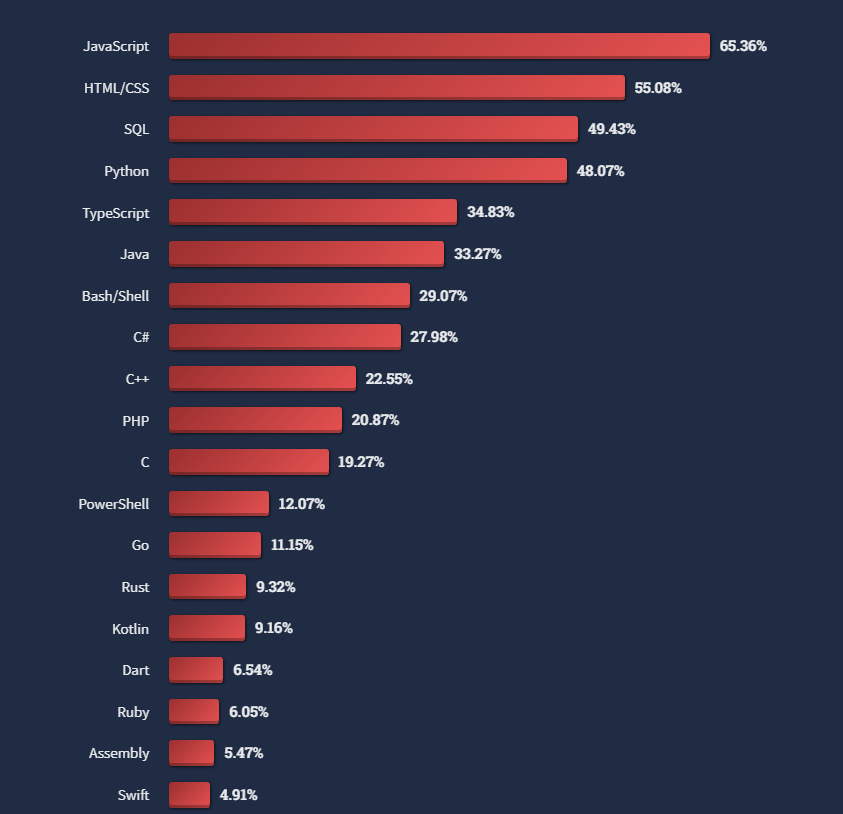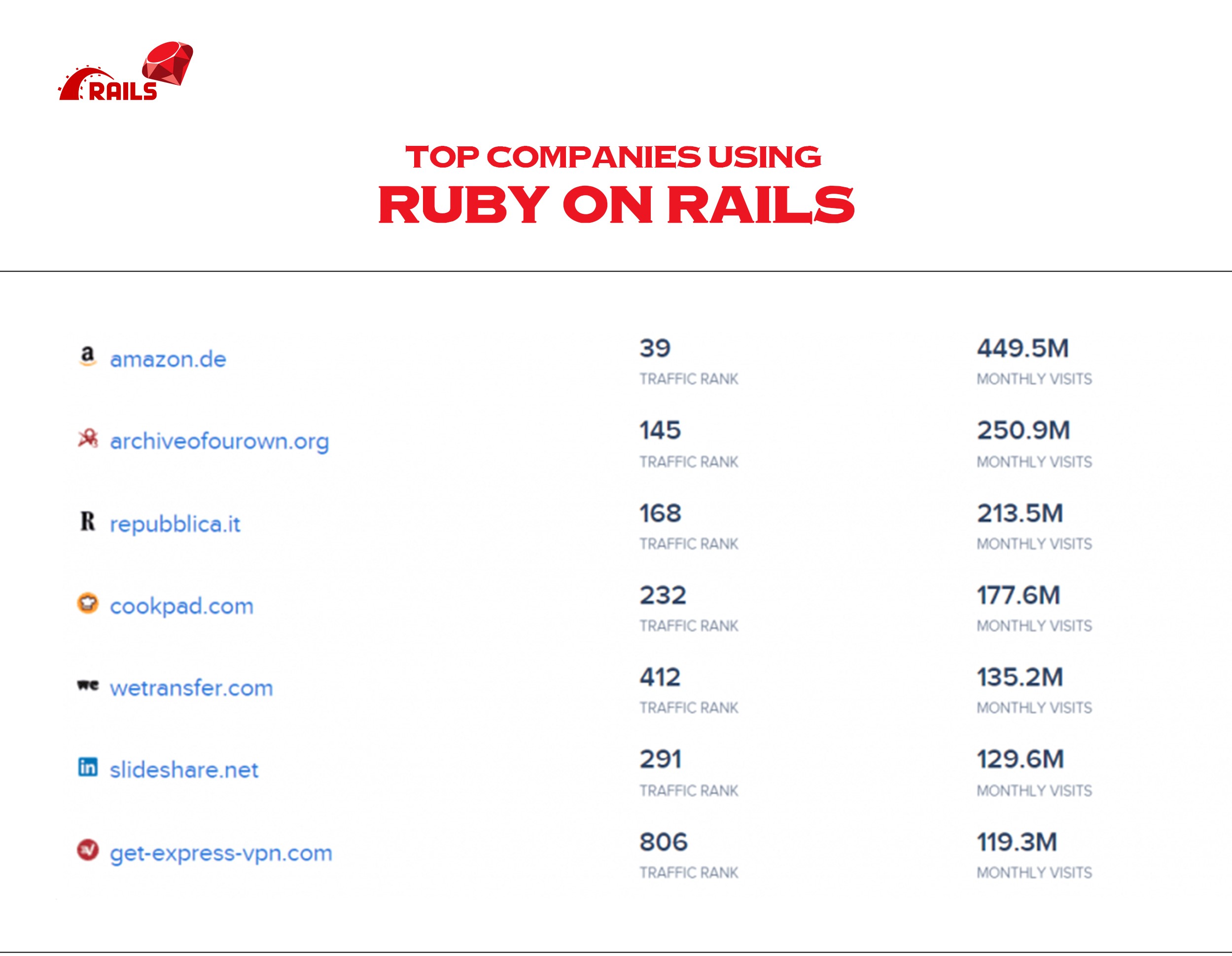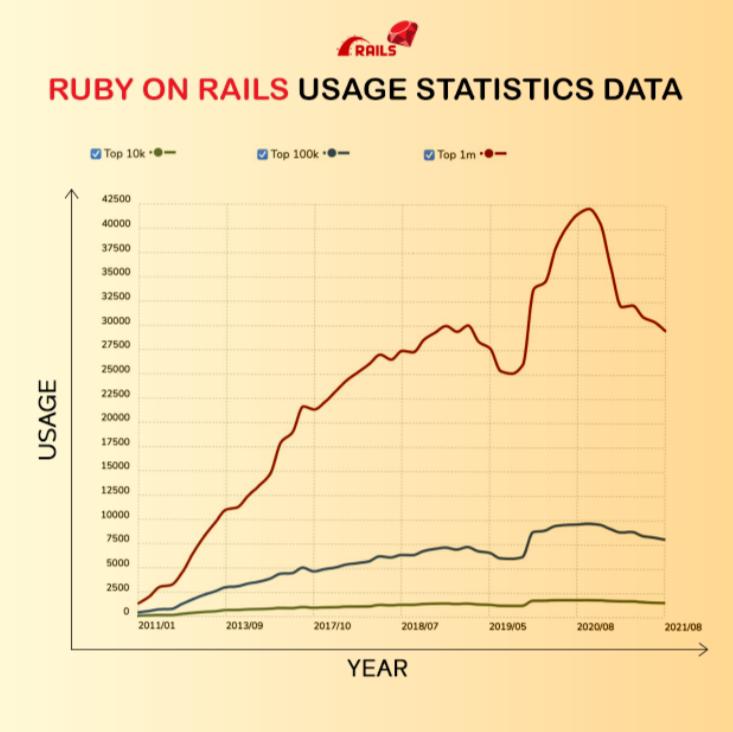Why Ruby on Rails Is Still Relevant in 2023
Ruby on Rails is a prominent framework utilized by startups for its rapid development capabilities. Then why do some people declare it irrelevant today?
Join the DZone community and get the full member experience.
Join For FreeRuby on Rails is an open-source framework based on the Ruby programming language used for developing web applications. Though mostly associated with the backend, the framework is full stack with applications in eCommerce websites and business development. Many giants, such as Netflix, Airbnb, GitHub, etc., use the framework. Then why are we pelted with remarks like ‘Ruby is outdated’ and ‘Rails is irrelevant today'?
Rails are going to be 20 years old soon. Though its popularity has declined over the years, it is nowhere going to die soon.

All opinions suggesting Ruby on Rails is dead are fake rumors. Such rumors are very common in the software development field. Lots of languages and frameworks are pronounced dead, but that is always so far from the truth. So, what’s special about Ruby on Rails, and why should you consider it for your web project in 2023?
Brief History of Ruby on Rails
Ruby on Rails was developed by David Heinemeier Hansson in August 2004 under an MIT license and was released in 2005. It quickly revolutionized the web development industry with its innovative features, such as seamless database migration, table creation, and scaffolding of views for rapid app development. It also brought a convention-over-configuration paradigm that helps developers at many levels of software design. It is built on the Model-View-Controller framework and works on software development principles such as:
- Don’t Repeat Yourself: Reduces code and pattern repetitions.
- Active Record Pattern: Eases Object-relational mapping.
- Convention-Over-Configuration: Decreases the number of decisions taken by the developer.
With these concepts at hand, Ruby on Rails provides quick app development and deployment processes with flexibility and ease of coding, which you may not find in any other similar framework. It helped Ruby on Rails developers in avoiding the hassles of coding and focus more on the business and logic aspects of the app.
Why Do People Think That Ruby on Rails Is Dying?
Ruby on Rails is a powerful framework, especially for developing a prototype application. It is also the most cost-effective. Hence, the reason why businesses flock to it. For developers, it provides a stable, flexible, quick, and simple coding experience.
Why the hate, then? For sure, if the technology is not used properly or isn’t updated to the latest versions, it is bound to lose support, and the creators also will not get the crucial feedback required to further develop the framework.
Two major issues developers talk about:
1. Performance Issues:
Ruby on Rails does have some issues with the CPU. It also has a slower runtime speed compared to other similar frameworks, such as Node.JS. The issue is noticeable when there is a huge app with lots of traffic and user requests; the framework is bound to take up the load. Moreover, the server and database also play an important role in affecting the speed. Otherwise, programs and apps built in rails are inherently fast. Consider GitHub or Airbnb, which deal with large-scale traffic daily and have their built-in backend Rails.
So what’s the issue? Well, Rails has lots of libraries and tools, and inexperienced developers tend to make wrong decisions with them while writing the code. The performance will surely hinder. Otherwise, the creators have actively been working on improving the performance with each update:
- Ruby 3 aimed to provide thrice the speed of Ruby 2.
- Rails 6.0 packs in-built features and solutions to simplify web development.
- Rails 7.0 included more features, such as asynchronous query loading, js bundling-rails integration, etc., to enhance performance.
2. Scalability Issues
Ruby on Rails was called ‘difficult to scale up’ when Twitter decided to rewrite its backend in Scala, which was previously in Rails. This was the first instance that started the debate over this issue. But, was Rails the hindrance?
Scaling up means handling more clients and users at a given time. To serve them quickly, each server-side element of the application should be configured accordingly to provide optimal performance. A middle-level or small-level application can handle traffic easily. But for large-scale applications, one of the best things to do is to build it in one language so that it becomes easier to connect and sync all the segments together. Twitter moved to Scala because it was written in JavaScript. Additionally, Scala can handle large-scale real-time messaging, so it was a better option for Twitter.
But it doesn’t suggest that Ruby on Rails cannot provide scalability. Rails provide a lot of features such as service-oriented architecture, code optimization, horizontal scaling, and threat safety which allows your application to handle more traffic and to easily plug-in additional servers if required. Some large traffic companies that utilize Ruby on Rails are listed in the image below.

Ruby on Rails in Comparison With Other Languages
Java
Java has been the most popular language since its inception. One clear distinction it has with Ruby is in the way of code execution. In Java, code is translated into a virtual machine language before execution. No such translations are required in Ruby before executing the code.
| Java | RUBY on rails |
|---|---|
| Requires More Lines Of Codes | Very Few Lines Of Code Are Required For A Similar Function |
| Slow Development | Faster Development |
| Code Needs to be Compiled, and Interpreted | No Need for a Compiler |
| Testing and Debugging is Difficult | Testing, and Debugging is Easier |
| Better Application Performance | Better Flexibility And Readability |
| Bigger Community of Experts | Not as Big as Java |
| Java Virtual Machine Can Execute Code Faster | Since No Compiler, Code Gets Directly Executed |
Python
Python and Ruby are both prominent backend languages with a plethora of libraries and powerful frameworks. They are both at the top of their games and can be utilized for cross-platform applications. However, Ruby offers more freedom in Syntax than Python.
Python indulges in simplifying codes by allowing a single statement of code per line. However, this makes every Python code appear similar, hence confusing.
Ruby allows flexibility through manifold statements per line. They allow programmers to indent code whenever required.
| Python | Ruby |
|---|---|
| High-Level Language | General Purpose |
| Less Object-Oriented | Full Object-Oriented |
| Supports Multiple IDEs | Only Supports EclipseIDE |
| Has More Libraries | Has Fewer Libraries |
| Has Functions | Doesn’t Have functions |
| No Modifications On Built-In Classes | Can Modify Built-In Classes |
| Multiple Inheritance | Single Inheritance. |
PHP
PHP is a general-purpose server-side scripting language like Ruby, which is used to develop almost all types of web content. Like Ruby, it is also fast, pragmatic, flexible, and object-oriented.
| PHP | RUBY ON RAILS |
|---|---|
| Faster Code Execution | Slower Code Execution |
| More Lines Of Codes for a Program | Few Lines Of Codes for The Same Program |
| Web Hosting Companies Supports PHP Apps | RoR Apps Require Unix-Based Servers |
| Testing And Debugging are Difficult | Testing And Debugging are Easier |
| Not Much Clear Structure as RoR | More Clear Code Structure |
| Requires Low Memory Space | Requires High Memory Space |
| Suitable For Any Kind Of Web Application | More Suitable For Business Web Applications |
Perl
Perl is a high-level, general-purpose, dynamic programming language. It can render a variety of paradigms, tools, and other language features. It can be used for networking, system administration, etc. One drawback is that programmers tend to work with a single paradigm; thus, the unused features sometimes create confusion. Ruby doesn’t have such issues due to its flexibility and conventions.
| PERL | ruby on rails |
|---|---|
| Less Object- Oriented | More Object- Oriented |
| Less Number of Libraries | More Number of Libraries |
| Supports More Unicode Properties | Less Supportive |
| Strings Encoding is Less Explicit | Strings Encoding is More Explicit |
| Multiple Variable Types | Single Variable Types |
| Supports Auto Conversion of Data | Requires Programmers To Convert Types Explicitly |
| Suitable For Any Kind Of Web Application | More Suitable For Business Web Applications |
Why Choose Ruby on Rails Framework For Your Project?
Ruby on Rails is a fairly mature technology with a huge community of developers. It is a developer-friendly framework with more than a million web applications and websites built on it and still counting.

It provides flexibility, ease of coding, and speed that helps in building a scalable app quickly.
Some More Reasons for Choosing Ruby on Rails
1. Business Logic Execution
Ruby on Rails can implement complex business logic in a simple and fast process. You can use it with front-end frameworks such as React and have it developed fast.
2. Gems
Ruby has a huge collection of gems in the repository. Gems are pre-written lines of codes, libraries, and tools that you can use to write codes more efficiently. They help tremendously in reducing code complexity, provide high-end features, and are reusable.
3. Rapid Development
Ruby on Rails is famous for its rapid development process. Creating a project with Ruby is fairly easy, and it works best if you want to deploy your prototype quickly. Ruby utilizes fewer lines of codes and Gems which further helps in the quick development of applications. Compared to other frameworks and languages, Ruby on Rails can develop applications 40-45% more quickly.
Conclusion
Ruby on Rails had its best time during 2015 and has matured ever since, but its popularity and usefulness are still intact. The framework is highly utilized by startups today due to its advantages in rapid prototyping. The upcoming releases and upgrades also sound promising.
With that, we cannot say that RoR has any indications of becoming obsolete anytime soon. It sure has its pros and cons and does lack performance compared to some of the other frameworks, but its advantages far outweigh the drawbacks. Hopefully, shortly we can see Ruby on Rails back at the top of the list again.
Opinions expressed by DZone contributors are their own.

Comments